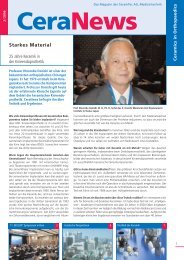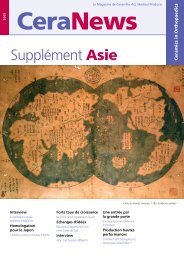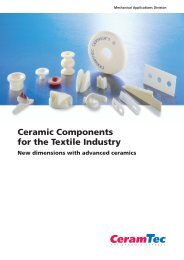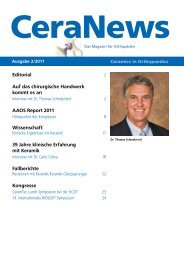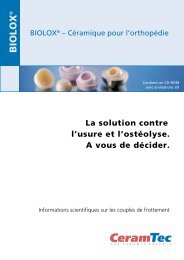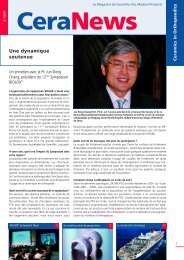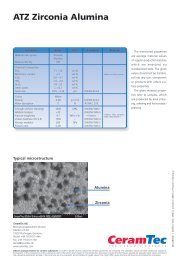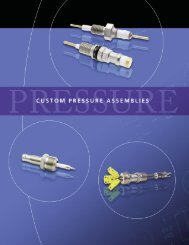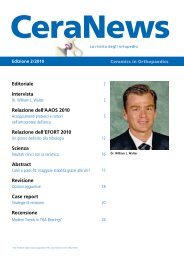BIOLOX - CeramTec
BIOLOX - CeramTec
BIOLOX - CeramTec
You also want an ePaper? Increase the reach of your titles
YUMPU automatically turns print PDFs into web optimized ePapers that Google loves.
<strong>BIOLOX</strong> ®<br />
<strong>BIOLOX</strong> ® – Ceramics for Hip Arthroplasty<br />
Contains CD ROM<br />
with 3-D Animation<br />
It’s in Your Hands:<br />
The Low Wear Choice<br />
Against Osteolysis<br />
Scientific Information on Wear Couples
Particle Problem<br />
Material Answers<br />
Large Diameters<br />
Wear Couples<br />
Particle-induced Osteolysis: The Most Important Cause<br />
for Aseptic Loosening and Related Complications<br />
Inevitable Revision<br />
Greater Activity, More Wear<br />
2<br />
Total hip replacement (THR) is one of the<br />
most successful surgical procedures in general.<br />
Yet, a few problems remain unsolved,<br />
and aseptic loosening is probably the most<br />
important of them. One of the main<br />
reasons for aseptic loosening in total hip<br />
replacement is the foreign body reaction<br />
caused by the wear particles which are<br />
created by the articulating femoral ball<br />
head and cup inlay. 29 (Fig. 1). The end result<br />
of this process is osteolysis, making<br />
revision surgery necessary in roughly 75%<br />
of these cases. 26<br />
The younger and more active patients of<br />
today place very high demands on the<br />
performance of their THR. Daily work,<br />
sports, an intensive social and family life<br />
often add up to a high level of activity.<br />
What improves the quality of life on the<br />
one hand also leads to a rising quantity of<br />
wear particles from the artificial joint on<br />
the other, eventually increasing the risk of<br />
particle-induced osteolysis.<br />
Known factors influencing the<br />
production of wear particles are:<br />
• patient activity<br />
• the wear couple material properties<br />
• the diameter of the wear couple<br />
• the roughness of the surface<br />
• the presence of third body wear.<br />
Fig. 1:<br />
Severe osteolysis<br />
caused by the wear<br />
particles of a metalpolyethylene<br />
bearing,<br />
15 years post-op<br />
Wollmerstedt et al. clinical study:<br />
Wollmerstedt et al. 32 measured real life<br />
activity levels of THR patients. The result<br />
was roughly 2 million load cycles per year<br />
at an average age of 70, twice as high<br />
as the assumption of 1 million cycles<br />
equalling 1 year used in simulator studies.<br />
The authors conclude that the quality of<br />
the wear couples is even more important<br />
than previously thought.
<strong>BIOLOX</strong> ® Makes the Difference<br />
Goals to Achieve<br />
The problems created by wear debris in THR<br />
bearing systems containing polyethyl ene or<br />
metal make reducing wear an imperative.<br />
The objective must be to avoid the need<br />
for revision while still allowing the patient<br />
to live a normal or even high activity lifestyle.<br />
Therefore, articulating materials<br />
should have:<br />
• the lowest production of wear particles<br />
• the best biological behaviour from<br />
generated wear particles<br />
• the lowest osteolytic potential<br />
• the lowest coefficient of friction.<br />
Fig. 2:<br />
Neocapsule of an<br />
autopsy specimen of<br />
a patient with ceramicceramic<br />
couple after<br />
8 years in vivo<br />
show ing no ceramic<br />
particles, smooth<br />
syno vial surface and<br />
moderate fibrosis. 6<br />
3<br />
All of these goals combined can be met<br />
by utilizing ceramic bearing surfaces.<br />
<strong>BIOLOX</strong> ® components can greatly help<br />
in the prevention of revision surgery.<br />
Source: Bos I, Institute of Pathology, University of Lübeck (Germany)<br />
Fig. 3 Fig. 4<br />
Fig. 3:<br />
Male, 30 years,<br />
preoperative X-ray of<br />
left hip joint with<br />
coxarthrosis; right hip<br />
joint with ceramic-onceramic<br />
THR 8 years<br />
after implantation<br />
Source: Garino J, University of Pennsylvania (USA)<br />
Fig. 4:<br />
Postoperative X-ray,<br />
left hip joint also with<br />
ceramic-on-ceramic<br />
THR
Particle Problem<br />
Material Answers<br />
Large Diameters<br />
Wear Couples<br />
The Ideal Technology for Preventing Osteolysis:<br />
The <strong>BIOLOX</strong> ® Ceramic Family of Products<br />
Reducing Wear<br />
The Advantages of <strong>BIOLOX</strong> ® Products<br />
4<br />
There is a direct relationship between the<br />
amount of wear and the risk of osteolysis.<br />
The use of ceramic femoral ball heads that<br />
articulate against ceramic, polyethylene or<br />
crosslinked polyethylene inserts provides<br />
the best solution for a selective approach<br />
to the problems of osteolysis.<br />
• They produce the lowest particle<br />
and osteolytic potential of all commonly<br />
used bearing materials.<br />
• They have the potential to create the<br />
lowest risk of particle-induced osteolysis<br />
and loosening.<br />
• They have an extremely low level of<br />
biological activity due to their chemical<br />
composition, size and shape of ceramic<br />
particles.<br />
• They are also specially suited for patients<br />
with hypersensitivity to metals.<br />
Linear Wear Rates in Vivo<br />
mm per year<br />
0.2<br />
0.15<br />
Tab. 1:<br />
Linear wear rates produced<br />
by different wear couples<br />
in total hip joints. Different<br />
XPE varieties show widely<br />
differing results in the Me/<br />
XPE studies.<br />
0.1<br />
0.05<br />
0<br />
Me/PE Ce/PE Me/XPE Ce/XPE Me/Me Ce/Ce<br />
Sources:<br />
Greenwald AS, Garino JP. Alternative bearing surfaces: the good, the bad, and the ugly. J Bone Joint Surg 83-A, Suppl 2 Pt 2: 68-72, 2001<br />
Hendrich C, Wollmerstedt N, Ince A, Mahlmeister F, Göbel S, Nöth U. Highly Crosslinked Ultra Molecular Weight Polyethylene- (UHMWPE-) Acetabular<br />
Liners in combination with 28mm <strong>BIOLOX</strong> ® heads, in: F. Benazzo, F. Falez, M. Dietrich (eds): Bioceramics and Alternative Bearings in Joint<br />
Arthroplasty. 11th <strong>BIOLOX</strong> ® Symposium Proceedings. Steinkopff Verlag Darmstadt: p.182, 2006<br />
Martell JM, Verner JJ, Invaco SJ. Clinical performance of a highly cross-linked polyethylene at two years in total hip arthroplasty: A randomized prospective<br />
trial. J Arthroplasty 18 (7 suppl. 1):55-59, 2003<br />
Zichner LP, Willert HG: Comparison of Alumina Polyethylene and Metal Polyethylene in Clinical Trials. Clin Orthop Rel Res 282:86-94, 1992<br />
Zichner LP, Lindenfeld T. In-vivo-Verschleiß der Gleitpaarungen Keramik-Polyetyhlen gegen Metall-Polyethylen. (In vivo wear of ceramics-polyethylene<br />
in comparison with metal-polyethylene.) Orthopäde 26:129-134, 1997<br />
Bragdon CR, Barrett S, Martell J, Greene ME, Malchau H, Harris WH. Steady-State Penetration Rates of Electron Beam–Irradiated, Highly Cross-<br />
Linked Polyethylene at an Average 45-Month Follow-Up. J Arthroplasty 21/7: 935-943, 2006;<br />
Manning, DW, Chiang PP, Martell J, Galante JO, Harris WH. In Vivo Comparative Wear Study of Traditional and Highly Cross-linked Polyethylene in<br />
Total Hip Arthroplasty. J Arthroplasty 20/7: 880-886, 2005
Compatible Materials:<br />
<strong>BIOLOX</strong> ® forte and <strong>BIOLOX</strong> ® delta<br />
Proven technology<br />
Additional options<br />
<strong>BIOLOX</strong> ® has been in use since 1974.<br />
More than 4,500,000 components have<br />
been implanted since then all over the<br />
world. The clinical results have been excellent.<br />
The material has proven its superior<br />
properties and is considered the standard<br />
by which all other ceramics used in orthopedics<br />
are evaluated.<br />
Still, <strong>CeramTec</strong> is continuously working<br />
on making the good even better. New<br />
challenges placed by young, active<br />
and heavy patients have to be met.<br />
Ad ditional head sizes, smaller acetabular<br />
components, increased stability and longevity<br />
are the obvious goals of research and<br />
development.<br />
The new alumina matrix composite,<br />
<strong>BIOLOX</strong> ® delta, meets these increased<br />
demands. It is a high performance ceramic<br />
developed by <strong>CeramTec</strong> as a logical<br />
complement to our well-proven <strong>BIOLOX</strong> ®<br />
forte. It allows us to offer new sizes and<br />
applications not achievable with <strong>BIOLOX</strong> ®<br />
forte. <strong>BIOLOX</strong> ® delta provides all the<br />
advantages of <strong>BIOLOX</strong> ® forte: excellent<br />
biocompatibility, highly enhanced mechanical<br />
properties, superb chemical and<br />
hydrothermal stability. At the same time<br />
it has tribological characteristics even<br />
superior to <strong>BIOLOX</strong> ® forte.<br />
5<br />
From a tribological<br />
point of view femoral<br />
ball heads and cup inserts<br />
made of<br />
<strong>BIOLOX</strong> ® forte and<br />
<strong>BIOLOX</strong> ® delta can be<br />
combined with one<br />
another. <strong>BIOLOX</strong> ® forte<br />
and <strong>BIOLOX</strong> ® delta<br />
femoral ball heads can<br />
also be combined with<br />
cup inserts made of<br />
polyethylene and highly<br />
crosslinked polyethylene<br />
(XPE).
Particle Problem<br />
Material Answers<br />
Large Diameters<br />
Wear Couples<br />
<strong>BIOLOX</strong> ® Ceramic Wear Couples in Larger Sizes:<br />
Even More Longevity and Safety<br />
More ROM, More Stability<br />
6<br />
Instability and dislocation of THR represent<br />
serious complications. After aseptic loosening,<br />
they are the most common reasons<br />
for revision surgery. 26 The incidence of<br />
dislocation following primary THR ranges<br />
from roughly 1% and 5% and for revision<br />
22, 28<br />
surgery it can be as high as 10%.<br />
40mm Ø<br />
ROM 152°<br />
Many everyday activities<br />
require strong<br />
flexion or abduction<br />
of the hip joint.<br />
In a conventional<br />
artificial hip these<br />
move ments may<br />
cause impingement<br />
and dislocation.<br />
Large diameter wear<br />
couples increase<br />
the range of motion<br />
(ROM) significantly.<br />
28mm Ø<br />
ROM 123°
Lower Risk of Impingement<br />
and Subluxation<br />
Increased diameter wear couples enhance<br />
the stability, post-operative mobility and<br />
Clinical studies confirm that there is a<br />
statistically significant decrease in impinge-<br />
7<br />
range of motion of THR. All of these gains ment, subluxation and dislocations with<br />
be obtained. 2,8,9,15,23,24 28mm wear couple (assuming<br />
are very helpful in providing the patient<br />
with a more reliable joint replacement.<br />
32mm and 36mm ceramic wear couples<br />
(0.88%) when compared to 28mm femoral<br />
ball heads (4.63%) in THR. 33<br />
One of the key advantages of the use of<br />
increased diameter ceramic femoral ball<br />
heads is that the distance required for a<br />
femoral ball head to subluxate increases by<br />
However, studies have shown that utilizing<br />
a large femoral ball head diameter could<br />
also increase the risk of bone impingement Comparison of the ROM<br />
between a 28mm and<br />
up to 4mm when comparing the 28 to the and cause dislocation. Therefore a good a 40mm ceramic wear<br />
36mm wear couple, making it less likely to compromise of head size to managed couple shows a gain of<br />
29° in ROM when selecting<br />
the 40mm wear<br />
dislocate. 20<br />
pros thetic and bone impingement must<br />
the same head-<br />
to-neck ratio). The angles<br />
refer to the technical<br />
Fig. 5: A larger head allows a wider range of motion<br />
range of motion.<br />
28mm Ø 32mm Ø<br />
36mm Ø 40mm Ø<br />
123° 130°<br />
136° 152°<br />
Fig. 6: More resistance to dislocation<br />
28mm Ø 36mm Ø 40mm Ø<br />
32mm Ø
Particle Problem<br />
Material Answers<br />
Large Diameters<br />
Wear Couples<br />
Large Diameters: Advantages and Disadvantages<br />
of Different Materials<br />
8<br />
The advantages of ceramic materials in<br />
wear couples become even more evident<br />
with large diameters. Hip joint simulator<br />
studies show that even though the surfaces<br />
exposed to friction are much bigger,<br />
the wear rates remain very low and are<br />
significantly lower than with other materials.<br />
With the use of ceramics the surgeon<br />
doesn’t have to compromise between<br />
wear rate and head size and can choose<br />
the best option for the patient.<br />
Hip Joint Simulator – Highly Crosslinked Polyethylene<br />
Long-term wear rate after 10 million cycles<br />
Negative Effect of Increased<br />
Metal Head Size<br />
Hip Joint Simulator – Highly Crosslinked Polyethylene<br />
Long-term wear rate after 10 million cycles<br />
Tab. 2 Positive Effect of Alumina Ceramic<br />
Femoral Ball Head Compared to<br />
Tab. 3<br />
Metal Femoral Ball Head<br />
Volume wear rate (mm 3 per million cycles)<br />
Volume wear rate (mm 3 per million cycles)<br />
12<br />
10<br />
8<br />
12<br />
10<br />
8<br />
6<br />
4<br />
2<br />
0<br />
Fisher J, University of Leeds, 2006<br />
6<br />
4<br />
2<br />
0<br />
Fisher J, University of Leeds, 2006<br />
28mm<br />
Metal femoral<br />
ball head on XPE<br />
36mm<br />
Metal femoral<br />
ball head on XPE<br />
36mm<br />
Metal femoral<br />
ball head on XPE<br />
36mm<br />
Alumina ceramic<br />
femoral ball head on XPE<br />
Source: Fisher J, University of Leeds (UK), 2006
Ceramic-on-ceramic bearings with large<br />
diameters combine all of the advantages<br />
of today’s tribological technology. Their<br />
biological and biomechanical properties<br />
help to spare natural anatomy and physiology<br />
to the greatest possible extent. Drastically<br />
reduced wear, a large range of<br />
motion as well as additional resistance to<br />
dislocation make these bearings the ideal<br />
choice for safety and longevity in total hip<br />
replacement.<br />
9<br />
In contrast to polyethylene and crosslinked<br />
polyethylene wear couples, the wear rate<br />
of ceramic-on-ceramic couples does not<br />
rise with increased head size. 1<br />
Fig. 7:<br />
Retrieval of a PE liner<br />
with a large diameter<br />
articulation, after 19<br />
years in vivo<br />
Source :<br />
Zweymüller K,<br />
Vienna (Austria)<br />
Function<br />
Tab. 4<br />
Head size (mm)<br />
40<br />
36<br />
36<br />
36<br />
40<br />
36<br />
Optimize function<br />
Increased stability, range of motion<br />
Maximize survivorship<br />
32<br />
32<br />
28<br />
28<br />
28<br />
28<br />
28<br />
22<br />
Metal on<br />
polyethylene<br />
22<br />
Metal<br />
on XPE<br />
Alumina<br />
on XPE<br />
Alumina on<br />
alumina ceramic<br />
Charnley principle<br />
High wear<br />
Survivorship<br />
Low wear<br />
Sources: Fisher J, University of Leeds (UK), 2006; Pandorf T, <strong>CeramTec</strong> AG (Germany), 2006
Particle Problem<br />
Material Answers<br />
Large Diameters<br />
Wear Couples<br />
The Charnley Principle Upgraded<br />
Step 1: <strong>BIOLOX</strong> ® Ceramic on Polyethylene (PE)<br />
10<br />
<strong>BIOLOX</strong> ® ceramic components have been<br />
clinically proven by the test of time as<br />
being effective in reducing wear and the<br />
incidence of osteolysis.<br />
• The use of <strong>BIOLOX</strong> ® ceramic femoral ball<br />
heads in conjunction with UHMWPE<br />
acetabular<br />
• The use of <strong>BIOLOX</strong> ® ceramic femoral ball<br />
heads in conjunction with UHMWPE<br />
acetabular modular components has<br />
demonstrated statistically significant<br />
reduction of wear debris (2 to 5 times<br />
less than a metal-on-polyethylene cou-<br />
21, 34, 35<br />
ple).<br />
• Long-term retrieval studies (see also Fig. 8)<br />
of components that have been implanted<br />
for 15–20 years demonstrate that<br />
<strong>BIOLOX</strong> ® femoral ball heads are com-<br />
pletely stable and do not undergo any<br />
changes in diameter, sphericity and<br />
surface rough ness when articulating<br />
30, 31, 36<br />
against poly ethylene.<br />
et al. Clinical Study:<br />
In a clinical study 34 , the same surgical technique<br />
was used to implant the same prosthesis<br />
with a <strong>BIOLOX</strong> ® femoral ball head<br />
or a metal femoral ball head. At a 10 year<br />
follow-up, the revision rate in the ceramicon-polyethylene<br />
THR group was reduced<br />
to one fifth of the level of the metal-onpolyethylene<br />
THR group.<br />
Urban et al. Clinical Study:<br />
Perhaps the strongest clinical proof available<br />
today on the use of <strong>BIOLOX</strong> ® ceramic<br />
femoral ball heads was published by Urban<br />
et al. 27 In their long-term follow-up study<br />
on ceramic-on-polyethylene THR using<br />
32mm <strong>BIOLOX</strong> ® femoral ball heads and<br />
cemented all-polyethylene cups, the mean<br />
linear polyethylene wear rates were<br />
0.034mm/yr. The survival rate without<br />
revision was 95% at 10 years, 89% at<br />
15 years and 79% at 20 years.<br />
• <strong>BIOLOX</strong> ® ceramic components have reduced<br />
the rate of loosening by a factor<br />
of more than 2 when compared to metal-<br />
Zichner<br />
34, 35<br />
on-polyethylene.<br />
Fig. 8:<br />
Retrieved <strong>BIOLOX</strong> ®<br />
femoral ball head on<br />
polyethylene after 15<br />
years in vivo
Step 2: <strong>BIOLOX</strong> ® Ceramic on Crosslinked Polyethylene (XPE)<br />
The new highly crosslinked Ultra High<br />
Molecular Weight Polyethylene (XPE) appears<br />
in the short term to be a significant<br />
advance in reducing polyethylene wear<br />
in combination with ceramic femoral ball<br />
heads of up to 40mm.<br />
Hendrich, Martell et al. Clinical Study:<br />
Hendrich, Martell et al. 18 showed a significantly<br />
reduced linear wear rate of 28mm<br />
<strong>BIOLOX</strong> ® forte heads in combination with<br />
highly crosslinked polyethylene after<br />
5 years of follow-up (see Tab. 1, p. 4). The<br />
patients were less than 60 years with a<br />
moderate activity level. In contrast patients<br />
with conventional polyethylene were significantly<br />
older with a lower activity level.<br />
This study suggests that the use of 28mm<br />
<strong>BIOLOX</strong> ® forte femoral ball heads and<br />
highly crosslinked polyethylene will be useful<br />
in further reducing wear even when<br />
comparing these diverse groups of patients.<br />
11<br />
Fig. 9:<br />
Total hip replacement<br />
combining a 28mm<br />
<strong>BIOLOX</strong> ® forte femoral<br />
ball head articulating<br />
against highly crosslinked<br />
polyethylene.<br />
Source:<br />
Hendrich C, Wollmerstedt N, Ince A, Mahlmeister F, Göbel S, Nöth U. Highly Crosslinked Ultra High Molecular Weight Polyethylene- (UHMWPE-)<br />
Acetabular Liners in combination with 28mm <strong>BIOLOX</strong> ® heads, in: F. Benazzo, F. Falez, M. Dietrich (eds): Bioceramics and Alternative Bearings in Joint<br />
Arthroplasty. 11th <strong>BIOLOX</strong> ® Symposium Proceedings. Steinkopff Verlag Darmstadt:p.182, 2006
Particle Problem<br />
Material Answers<br />
Large Diameters<br />
Wear Couples<br />
The Ultimate Solution for the<br />
Younger and More Active Patient<br />
Step 3: <strong>BIOLOX</strong> ® Ceramic-on-Ceramic Articulations<br />
12<br />
The <strong>BIOLOX</strong> ® ceramic-on-ceramic articulation<br />
has been consistently shown to<br />
provide the lowest wear rates both in vitro<br />
and in vivo when compared with other<br />
bearing surfaces (see Tab. 1, p. 4). <strong>BIOLOX</strong> ®<br />
ceramic-on-ceramic articulations generate<br />
wear particles with the lowest level of reactivity<br />
due to their size, shape and chemical<br />
composition. 5,11,12,16,19,25<br />
The much lower osteolytic potential of the<br />
ceramic debris 11,12,13 predicts the advantage<br />
that can be achieved by the clinical use of<br />
<strong>BIOLOX</strong> ® ceramic-on-ceramic articulations.<br />
The excellent performance is based<br />
on the following facts:<br />
• possesses unsurpassed wear reduction<br />
capability<br />
• offers superb biocompatibility and excellent<br />
stability in the human body 6,7,14,17<br />
• it is biocompatible in either bulk or in<br />
particulate<br />
• the hardness of the material is surpassed<br />
only by diamond, providing superb<br />
scratch resistance and the highest resistance<br />
of all bearing materials to thirdbody<br />
wear.<br />
• has an extensive and successful longterm<br />
clinical history.<br />
With ceramic wear<br />
couples the use of<br />
materials especially<br />
susceptible to wear can<br />
be avoided. The ceramics’<br />
material properties<br />
offer the low friction,<br />
low wear option for the<br />
longevity of total hip<br />
replacement.
Laboratory studies 12 conducted at the<br />
University of Leeds predicted that the<br />
functional biological activity (FBA) and<br />
osteo lytic potential of the ceramic-<br />
on-ceramic bearing combination will<br />
be lower than the metal-on-crosslinked<br />
combination as a result of the lower wear<br />
rate (see Tab. 5). Clinical evidence of this<br />
fact is demonstrated in the presence of<br />
limited anecdotal reports of osteolysis<br />
in THR systems utilizing the <strong>BIOLOX</strong> ®<br />
ceramic components.<br />
Bizot et al. Clinical Study:<br />
Hybrid alumina-on-alumina THR were performed<br />
on patients with a mean age of<br />
60.4 years. 32mm alumina femoral ball<br />
heads were used. The 12-year survival rate<br />
was 95.8% when aseptic loosening was<br />
considered as the end-point. 4<br />
Hip Joint Simulator<br />
Alumina Ceramic on Ceramic<br />
compared to Metal on Crosslinked PE<br />
Wear rate (mm 3 per million cycles)<br />
6<br />
Summary<br />
In vitro wear studies and in vivo retrieval<br />
studies confirm the fact that the use of<br />
ceramic bearings in THR provide the<br />
potential for the lowest risk of particleinduced<br />
osteolysis and increase the<br />
longevity of THR.<br />
D’Antonio et al. Clinical Study:<br />
In an FDA-controlled, prospective, double<br />
blinded, multi-center study 10 identical THR<br />
systems using either a ceramic-on-ceramic<br />
or a metal-on-polyethylene articulation were<br />
compared. The survival rate for ceramic-onceramic<br />
was 99.2% as opposed to 95.2%<br />
for metal-on-polyethylene at a minimum<br />
follow-up of 7 years. Osteolysis was present<br />
in three cases of the metal-on-polyethylene<br />
group while no osteolysis was reported for<br />
the ceramic-on-ceramic group.<br />
13<br />
5<br />
4<br />
3<br />
2<br />
1<br />
0<br />
Alumina<br />
ceramic –<br />
50 times<br />
lower wear<br />
Alumina ceramic<br />
28mm<br />
CoCr 28mm<br />
Nevelos et al. Mat. in Med 2001, Galvin et al. Soc Biomat 2004<br />
Source: Fisher J, University of Leeds, 2006<br />
Tab. 5:<br />
Even in comparison to<br />
metal-on-XPE the wear<br />
rate of ceramic-onceramic<br />
is lower by a<br />
factor of fifty.<br />
Alumina ceramic<br />
10 Mrad XPE<br />
Source: Fisher J, University of Leeds (UK), 2006
<strong>BIOLOX</strong> ® Ceramic Components for Hip Arthroplasty<br />
(Standard Products)<br />
Femoral Ball Heads<br />
14<br />
Head size Ø Neck length Material<br />
22.2mm s, m, l <strong>BIOLOX</strong> ® delta<br />
28mm s, m, l <strong>BIOLOX</strong> ® delta, <strong>BIOLOX</strong> ® forte<br />
32mm s, m, l <strong>BIOLOX</strong> ® delta, <strong>BIOLOX</strong> ® forte<br />
32mm xl <strong>BIOLOX</strong> ® delta<br />
36mm s, m, l, xl <strong>BIOLOX</strong> ® delta, <strong>BIOLOX</strong> ® forte<br />
40mm s, m, l, xl <strong>BIOLOX</strong> ® delta<br />
Inserts<br />
Inside Ø femoral ball head Outside Ø metalback *<br />
Material<br />
22.2mm not available not available<br />
28mm 42–70mm <strong>BIOLOX</strong> ® delta, <strong>BIOLOX</strong> ® forte<br />
32mm 46–70mm <strong>BIOLOX</strong> ® delta, <strong>BIOLOX</strong> ® forte<br />
36mm 50–70mm <strong>BIOLOX</strong> ® delta, <strong>BIOLOX</strong> ® forte<br />
40mm 54–70mm <strong>BIOLOX</strong> ® delta<br />
* The outside diameters of acetabular liners correspond with the size of<br />
the matching cup shells specific to implant system and manufacturer.<br />
Disclaimer<br />
This document is intended exclusively for experts in the<br />
field, i.e. physicians in particular, and is expressly not for<br />
the information of laypersons.<br />
The information on the products and / or procedures<br />
contained in this document is of a general nature and<br />
does not represent medical advice or recommendations.<br />
Since this information does not constitute any diagnostic<br />
or therapeutic statement with regard to any individual<br />
medical case, individual examination and advising of the<br />
respective patient are absolutely necessary and are not<br />
replaced by this document in whole or in part.<br />
The information contained in this document was gathered<br />
and compiled by medical experts and qualified<br />
<strong>CeramTec</strong> employees to the best of their knowledge.<br />
The greatest care was taken to ensure the accuracy<br />
and ease of understanding of the information used<br />
and presented. <strong>CeramTec</strong> does not assume any liability,<br />
however for the up-to-dateness, accuracy, completeness<br />
or quality of the information and excludes any liability<br />
for tangible or intangible losses that may be caused by<br />
the use of this information.<br />
In the event that this document could be construed as<br />
an offer at any time, such offer shall not be binding<br />
in any event and shall require subsequent confirmation<br />
in writing.
More Information<br />
Contents of the CD ROM<br />
References<br />
The literature cited in this<br />
brochure is listed on the attached<br />
CD ROM<br />
PowerPoint<br />
Presentations<br />
• Arthroplasty<br />
(Clinical Pictures)<br />
• Bone Sparing HR<br />
(Clinical and Product<br />
Pictures, Animations)<br />
• Products, Material,<br />
Tribology (Pictures<br />
and Animations)<br />
• The Production<br />
of Ceramics<br />
(Pictures)<br />
Product and<br />
Material Pictures<br />
• Ceramics<br />
– Material Properties<br />
– Heads and Inserts<br />
– Ceramic-on-Ceramic<br />
– Ceramic-on-PE<br />
– Revision Femoral<br />
Ball Head<br />
• Material Combinations<br />
• Metal<br />
• Wear Rates<br />
Clinical Pictures<br />
• Arthroplasty<br />
• Bone Sparing<br />
Hip Replacement<br />
The Production<br />
of Ceramics<br />
• Pictures<br />
Technical Monograph<br />
“Current Perspective<br />
on the Use of Ceramics<br />
in Total Hip Arthroplasty”<br />
15<br />
Please, find further detailed<br />
information on the enclosed<br />
CD ROM.<br />
The pictures, animations and<br />
presentation files, whether in<br />
total or as single slides, may be<br />
used freely for scientific and<br />
education purposes. The 3-D<br />
animations are included in files<br />
ending with the postfix “AVI”.<br />
Is the CD ROM missing from this brochure?<br />
If so, please contact us. We’ll be glad<br />
to send you one.
<strong>BIOLOX</strong> ®<br />
Ceramics in<br />
Orthopaedics<br />
<strong>CeramTec</strong> GmbH<br />
Medical Products Division<br />
<strong>CeramTec</strong>-Platz 1–9<br />
D-73207 Plochingen<br />
Tel. +49 7153 611 828<br />
Fax +49 7153 611 950<br />
E-Mail: medical_products@ceramtec.de<br />
www.biolox.com<br />
MT 060003·EN·1000·1204·Printed in Germany



